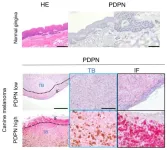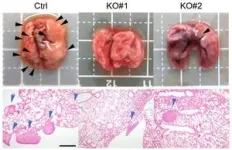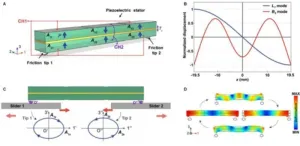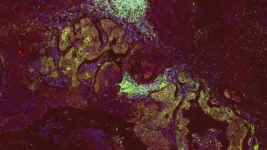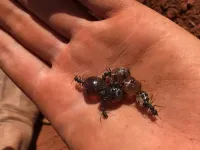(Press-News.org)
Although rare, mucosal melanoma in humans has a low survival rate. It has been difficult to investigate due to a lack of similar cancers in animals for study. Researchers explored a protein common to human and canine mucosal melanoma. The protein seems to be what makes this cancer so problematic, as it mobilizes the cancer cells, allowing them to spread. Researchers hope that eliminating this protein could lead to a potential treatment. The study is published in Molecular Cancer Research, a journal of the American Association for Cancer Research.
Melanoma is a type of cancer that begins in the melanocytes, the pigments that give skin its range of tones. Skin cancer accounts for about 90% of all melanomas in humans, but a small percentage are mucosal melanomas, which can manifest in the body’s various mucosal linings such as in the nose. Mucosal melanomas are hard to detect and even harder to treat, with a five-year survival rate of only 25%. Partly due to its rarity, and partly due to the lack of analogous forms of cancer in animals, it has been very difficult to research mucosal melanoma.
But a team of researchers, including those from the University of Tokyo’s Laboratory of Veterinary Surgery, has studied a common form of cancer in dogs and found some specific biological similarities that mean two things: Firstly, that there is a suitable animal model for mucosal melanoma in humans, and secondly, that they both involve a very specific marker that could be a target for reducing the spread of this, and potentially other, cancers.
“Even though mucosal melanoma is not so common in humans, it is very common in dogs. There was no known connection between the two, but we have recently discovered something common to both,” said Assistant Professor Daiki Kato. “There is a protein that accompanies mucosal melanomas called podoplanin (PDPN). It’s a membrane protein, meaning it is involved in some functions on the surface of a cell. We found that patients suffering mucosal melanoma with a high presence of PDPN succumbed to their cancer much sooner than those with less.”
The team studied PDPN to see what might make it so potentially deadly. It seems the protein can metastasize, or mobilize, otherwise static tumor cells. PDPN morphs tumor cells into something resembling a free-moving amoeba, which can squeeze between gaps in healthy tissue and move around to settle elsewhere in the body. This mechanism would explain why mucosal melanoma, in particular, sees such a quick spread of the cancer throughout the body.
“We are sure that this happens, but we still do not understand the entire mechanism behind why,” said Kato. “A big challenge is actually our data. As mucosal melanoma is rare, there just isn’t a lot of human data to learn from; our study had to combine different data sets and is not as complete as we would like. However, our tests involving PDPN do confirm our suspicion. When we took mucosal melanoma samples from dogs and eliminated the PDPN, the resulting tumor released far fewer metastasized cells which could spread and cause more harm. Though the samples came from dogs, that part of the experiment was carried out in mice.”
This means PDPN could be a target for antibody therapy. If new drugs can eliminate PDPN in patients with mucosal melanoma, it might reduce the spread, and suffering, it causes. The team is working toward this now and aims to run clinical trials in dogs, within a few years.
“Of course, we will continue to work toward treatments for both canine and human cancers. PDPN is just one avenue of attack,” said Kato. “But also of great importance is the fact that we have found an animal model for an often fatal human cancer, which opens up many possibilities for study.”
###
Journal article: Masahiro Shinada, Daiki Kato, Tomoki Motegi, Masaya Tsuboi, Namiko Ikeda, Susumu Aoki, Takaaki Iguchi, Toshio Li, Yuka Kodera, Ryosuke Ota, Yuko Hashimoto, Yosuke Takahashi, James Chambers, Kazuyuki Uchida, Yukinari Kato, Ryohei Nishimura, Takayuki Nakagawa. “Podoplanin drives amoeboid invasion in canine and human mucosal melanoma”, Molecular Cancer Research.
Funding:
This work was supported by JSPS KAKENHI (Grant Numbers 19K22361: Ryohei Nishimura, 20H03141: Daiki Kato, and 21K20614: Yosuke Takahashi) and in part by Japan Agency for Medical Research and Development (AMED) (Grant Numbers JP22ama121008 and JP22am0401013: Yukinari Kato).
Useful links:
Graduate School of Agricultural and Life Sciences - https://www.a.u-tokyo.ac.jp/english/
Research contact:
Assistant Professor Daiki Kato
Laboratory of Veterinary Surgery, Graduate School of Agricultural and Life Sciences,
The University of Tokyo, 1-1-1 Yayoi, Bunkyo-ku, Tokyo 113-8657, Japan
adk@g.ecc.u-tokyo.ac.jp
Press contact:
Mr. Rohan Mehra
Public Relations Group, The University of Tokyo,
7-3-1 Hongo, Bunkyo-ku, Tokyo, 113-8656, Japan
press-releases.adm@gs.mail.u-tokyo.ac.jp
About The University of Tokyo: The University of Tokyo is Japan's leading university and one of the world's top research universities. The vast research output of some 6,000 researchers is published in the world's top journals across the arts and sciences. Our vibrant student body of around 15,000 undergraduate and 15,000 graduate students includes over 4,000 international students. Find out more at www.u-tokyo.ac.jp/en/ or follow us on Twitter at @UTokyo_News_en.
END
As an electromechanical actuator, symmetric-actuating devices are often used in the fields where symmetrical motion, drive, and control are required, such as grasping or scissoring operations, and fast symmetric opening or closing of microchannels. One scenario with strong demand is minimally invasive surgery, including precision grasping and cutting tumor cells, retinal microsurgery, etc. In the field of micro electromechanical devices, the scissoring or grasping operation essentially belongs to two symmetrical actuations between two end-effectors. However, there is almost no one motor that can directly generate two symmetrical linear motions.
In general, to produce two symmetrical ...
DALLAS, July 26, 2023 — Existing research shows certain types of migraines can increase the risk of stroke, and there is growing evidence that they may also lead to other types of cardiovascular disease (CVD). To learn more about these connections, the American Heart Association, the world's leading nonprofit organization focused on heart and brain health for all, is providing a total of $2.1 million in grants for seven new scientific research projects. The selected teams of scientists for the “Migraine ...
NEW YORK, July 26, 2023 – The Blavatnik Family Foundation and the New York Academy of Sciences announced today the 2023 laureates of the Blavatnik National Awards for Young Scientists.
Each will receive $250,000, the largest unrestricted scientific award for America’s most innovative, faculty-ranked scientists and engineers who are under the age of 42. The winners and their distinguished research:
2023 Laureate in Life Sciences: William Anderegg, Ph.D., The University of Utah (Ecology & Evolutionary ...
Lymph nodes are one of the body’s first lines of defense against disease. Immune cells are dispatched from these biological police stations to fight off intruders. But somehow, lymph nodes are also the first stop for most metastatic cancers.
“It’s paradoxical,” Cold Spring Harbor Laboratory (CSHL) Assistant Professor Semir Beyaz says. “The cancer goes right in, but the immune cells aren’t doing anything. It’s important to understand what’s going on because this is how cancer takes the whole body hostage.”
Beyaz joined with collaborators from Massachusetts General Hospital to investigate. They ...
Researchers from WU Vienna University of Economics and Business, University of Bonn, and FAU Erlangen-Nürnberg published a new Journal of Marketing article that examines how consumers respond to new products co-developed with universities and the unique marketing opportunities for these products.
Firms often collaborate with universities to access novel scientific knowledge and technological expertise with an aim to develop superior new products. For example, Italian start-up Angles90 co-developed the first dynamic training grips with the faculty of Strength Training Ergonomics at the Technical University of ...
PULLMAN, Wash. –Sexual health, diet and exercise are the three topics that steal the show when it comes to popular health-related videos on TikTok. Unfortunately, there’s little else in terms of engaging health-related content on the video sharing platform, a Washington State University study found.
The social media platform’s mostly young audience also seems to prefer health-related videos featuring popular influencers’ role model appeals, such as their diet or exercise routine, rather than expert medical advice, ...
PARAMUS, N.J., July 26, 2023 – Octapharma USA today announced that Balfaxar® (prothrombin complex concentrate, human-lans; marketed in Europe and Canada as octaplex®) has received U.S. Food and Drug Administration (FDA) approval for the urgent reversal of acquired coagulation factor deficiency induced by vitamin K antagonist (VKA, e.g., warfarin) therapy in adult patients with need for urgent surgery or invasive procedures.
Balfaxar® helps restore blood coagulation by replenishing the levels of clotting factors that are deficient due to warfarin therapy. Balfaxar® ...
HOUSTON, GOLDEN, Colo. and WATERTOWN, Mass. ― The University of Texas MD Anderson Cancer Center and Nexo Therapeutics today announced a multi-year strategic collaboration that aligns the innovative technology and capabilities of each organization at the earliest stages of drug discovery and development to rapidly advance impactful new cancer therapies against previously undruggable targets.
The agreement brings together Nexo’s unique drug discovery platform, which combines innovative covalent chemistry and chemical biology, with the translational research and drug development expertise ...
Scientists have discovered the honey produced by Australian ants possesses unique anti-microbial activity against bacteria and fungi that could make the liquid useful medicinally.
The research, published today in PeerJ, was led by Andrew Dong and Dr Kenya Fernandes from the University of Sydney’s Carter Lab, which is led by Professor Dee Carter from the School of Life and Environmental Sciences and Sydney Institute for Infectious Diseases.
The team studied the Australian honeypot ant, Camponotus inflatus, which is found throughout desert areas mainly in Western Australia and the Northern Territory.
Among ...
Aurora, Colo. (July 26, 2023) – Children’s Hospital Colorado (Children’s Colorado) today announced the launch of the Precision Medicine Institute, which will allow experts to more efficiently integrate precision medicine into care provided to patients throughout the hospital. The Precision Medicine Institute uses innovative technology to integrate big data, including genomic data, into each individual patient's care plan to determine the best treatment for each patient.
Precision medicine, also known as personalized medicine or genomic medicine, uses the most up-to-date technology ...
